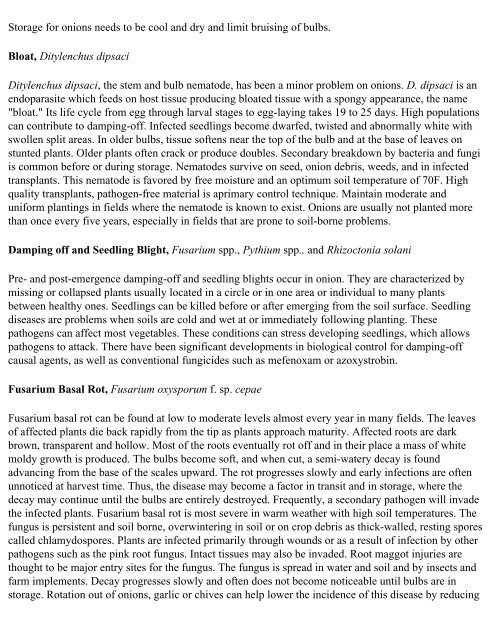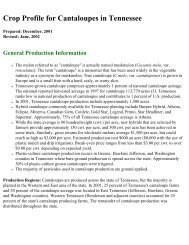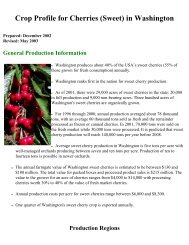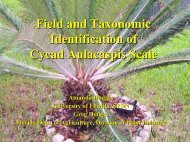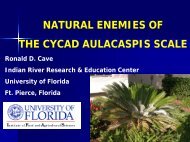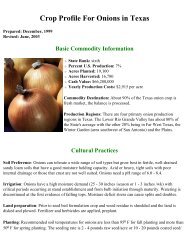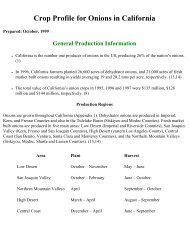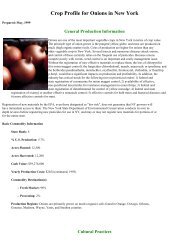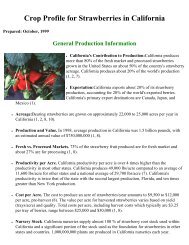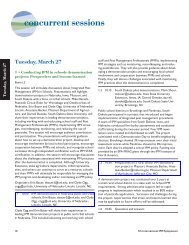Crop Profile for Onions in Colorado - Regional IPM Centers
Crop Profile for Onions in Colorado - Regional IPM Centers
Crop Profile for Onions in Colorado - Regional IPM Centers
You also want an ePaper? Increase the reach of your titles
YUMPU automatically turns print PDFs into web optimized ePapers that Google loves.
Storage <strong>for</strong> onions needs to be cool and dry and limit bruis<strong>in</strong>g of bulbs.<br />
Bloat, Ditylenchus dipsaci<br />
Ditylenchus dipsaci, the stem and bulb nematode, has been a m<strong>in</strong>or problem on onions. D. dipsaci is an<br />
endoparasite which feeds on host tissue produc<strong>in</strong>g bloated tissue with a spongy appearance, the name<br />
"bloat." Its life cycle from egg through larval stages to egg-lay<strong>in</strong>g takes 19 to 25 days. High populations<br />
can contribute to damp<strong>in</strong>g-off. Infected seedl<strong>in</strong>gs become dwarfed, twisted and abnormally white with<br />
swollen split areas. In older bulbs, tissue softens near the top of the bulb and at the base of leaves on<br />
stunted plants. Older plants often crack or produce doubles. Secondary breakdown by bacteria and fungi<br />
is common be<strong>for</strong>e or dur<strong>in</strong>g storage. Nematodes survive on seed, onion debris, weeds, and <strong>in</strong> <strong>in</strong>fected<br />
transplants. This nematode is favored by free moisture and an optimum soil temperature of 70F. High<br />
quality transplants, pathogen-free material is aprimary control technique. Ma<strong>in</strong>ta<strong>in</strong> moderate and<br />
uni<strong>for</strong>m plant<strong>in</strong>gs <strong>in</strong> fields where the nematode is known to exist. <strong>Onions</strong> are usually not planted more<br />
than once every five years, especially <strong>in</strong> fields that are prone to soil-borne problems.<br />
Damp<strong>in</strong>g off and Seedl<strong>in</strong>g Blight, Fusarium spp., Pythium spp., and Rhizoctonia solani<br />
Pre- and post-emergence damp<strong>in</strong>g-off and seedl<strong>in</strong>g blights occur <strong>in</strong> onion. They are characterized by<br />
miss<strong>in</strong>g or collapsed plants usually located <strong>in</strong> a circle or <strong>in</strong> one area or <strong>in</strong>dividual to many plants<br />
between healthy ones. Seedl<strong>in</strong>gs can be killed be<strong>for</strong>e or after emerg<strong>in</strong>g from the soil surface. Seedl<strong>in</strong>g<br />
diseases are problems when soils are cold and wet at or immediately follow<strong>in</strong>g plant<strong>in</strong>g. These<br />
pathogens can affect most vegetables. These conditions can stress develop<strong>in</strong>g seedl<strong>in</strong>gs, which allows<br />
pathogens to attack. There have been significant developments <strong>in</strong> biological control <strong>for</strong> damp<strong>in</strong>g-off<br />
causal agents, as well as conventional fungicides such as mefenoxam or azoxystrob<strong>in</strong>.<br />
Fusarium Basal Rot, Fusarium oxysporum f. sp. cepae<br />
Fusarium basal rot can be found at low to moderate levels almost every year <strong>in</strong> many fields. The leaves<br />
of affected plants die back rapidly from the tip as plants approach maturity. Affected roots are dark<br />
brown, transparent and hollow. Most of the roots eventually rot off and <strong>in</strong> their place a mass of white<br />
moldy growth is produced. The bulbs become soft, and when cut, a semi-watery decay is found<br />
advanc<strong>in</strong>g from the base of the scales upward. The rot progresses slowly and early <strong>in</strong>fections are often<br />
unnoticed at harvest time. Thus, the disease may become a factor <strong>in</strong> transit and <strong>in</strong> storage, where the<br />
decay may cont<strong>in</strong>ue until the bulbs are entirely destroyed. Frequently, a secondary pathogen will <strong>in</strong>vade<br />
the <strong>in</strong>fected plants. Fusarium basal rot is most severe <strong>in</strong> warm weather with high soil temperatures. The<br />
fungus is persistent and soil borne, overw<strong>in</strong>ter<strong>in</strong>g <strong>in</strong> soil or on crop debris as thick-walled, rest<strong>in</strong>g spores<br />
called chlamydospores. Plants are <strong>in</strong>fected primarily through wounds or as a result of <strong>in</strong>fection by other<br />
pathogens such as the p<strong>in</strong>k root fungus. Intact tissues may also be <strong>in</strong>vaded. Root maggot <strong>in</strong>juries are<br />
thought to be major entry sites <strong>for</strong> the fungus. The fungus is spread <strong>in</strong> water and soil and by <strong>in</strong>sects and<br />
farm implements. Decay progresses slowly and often does not become noticeable until bulbs are <strong>in</strong><br />
storage. Rotation out of onions, garlic or chives can help lower the <strong>in</strong>cidence of this disease by reduc<strong>in</strong>g


